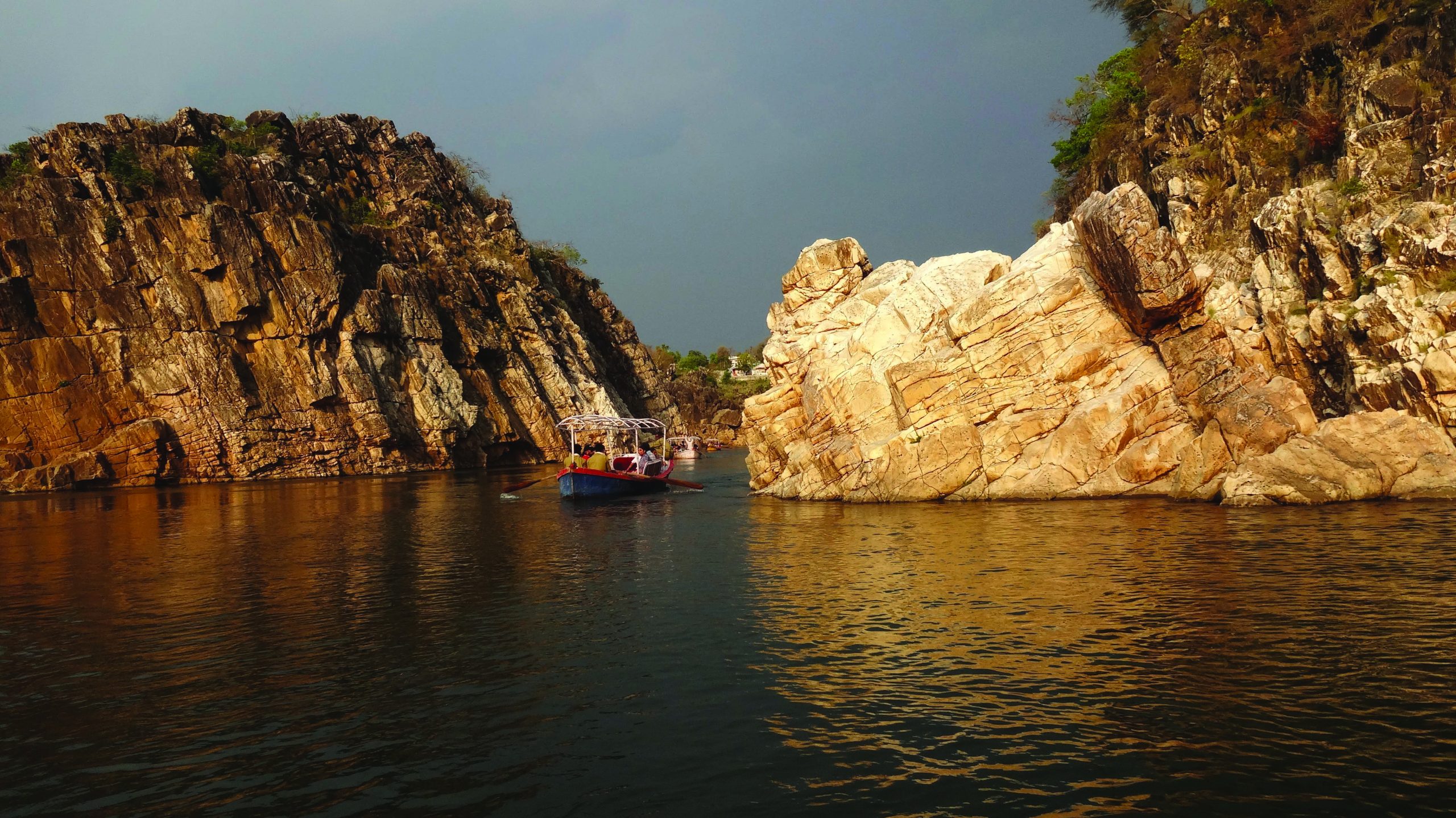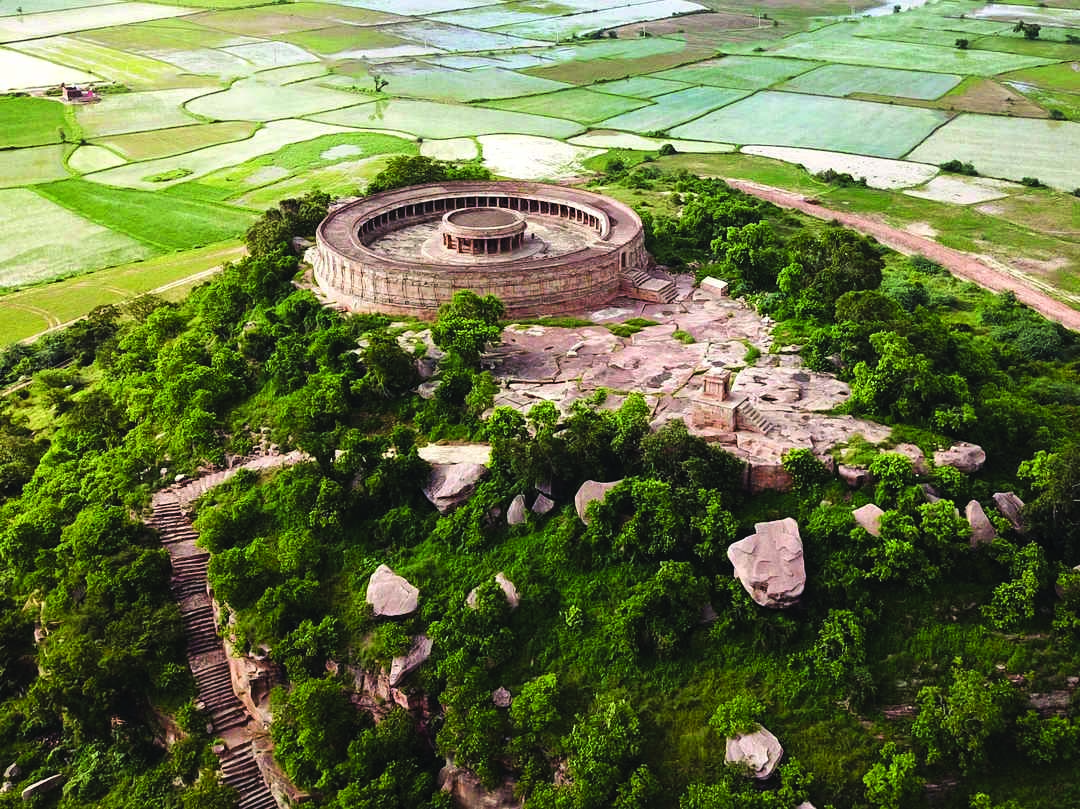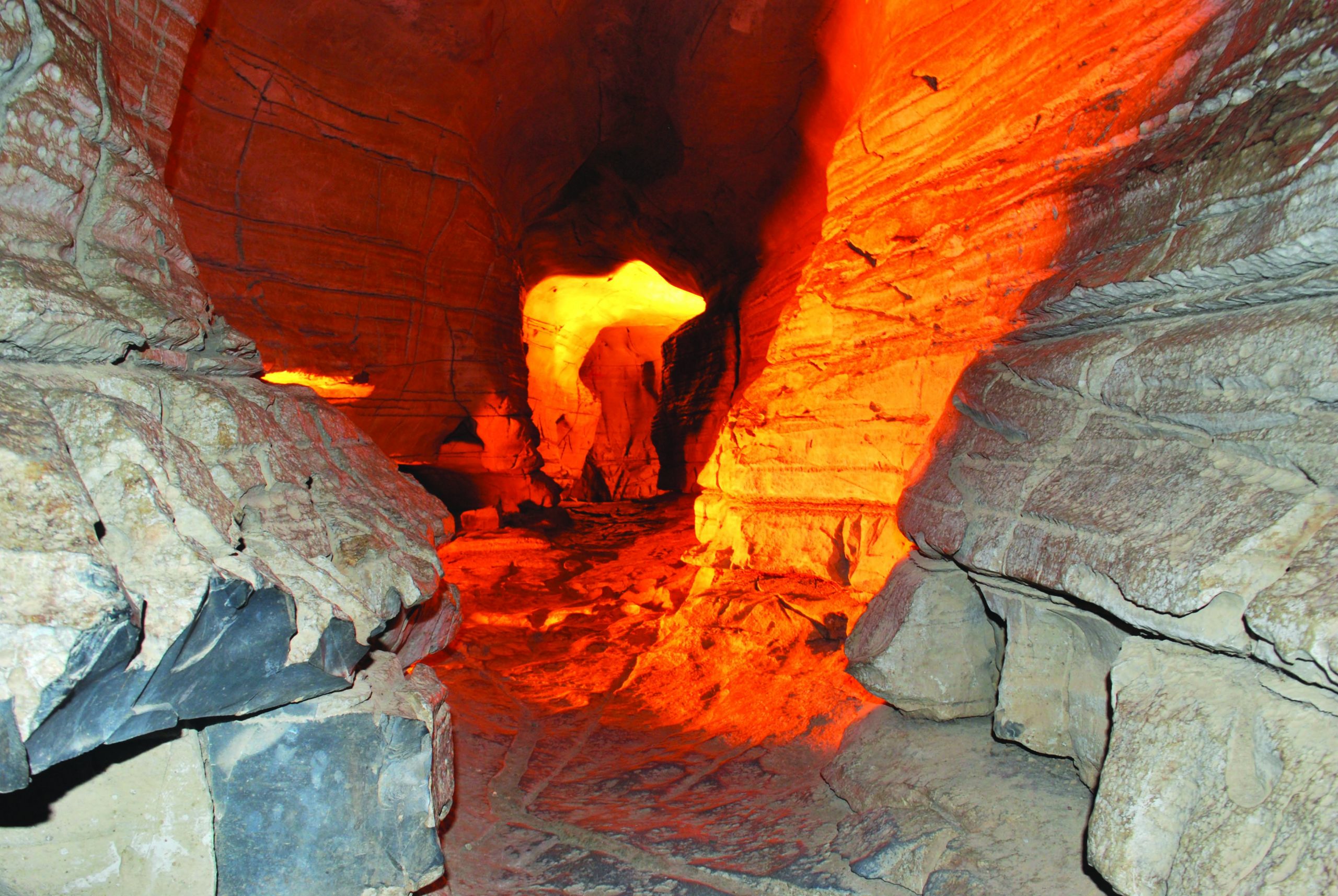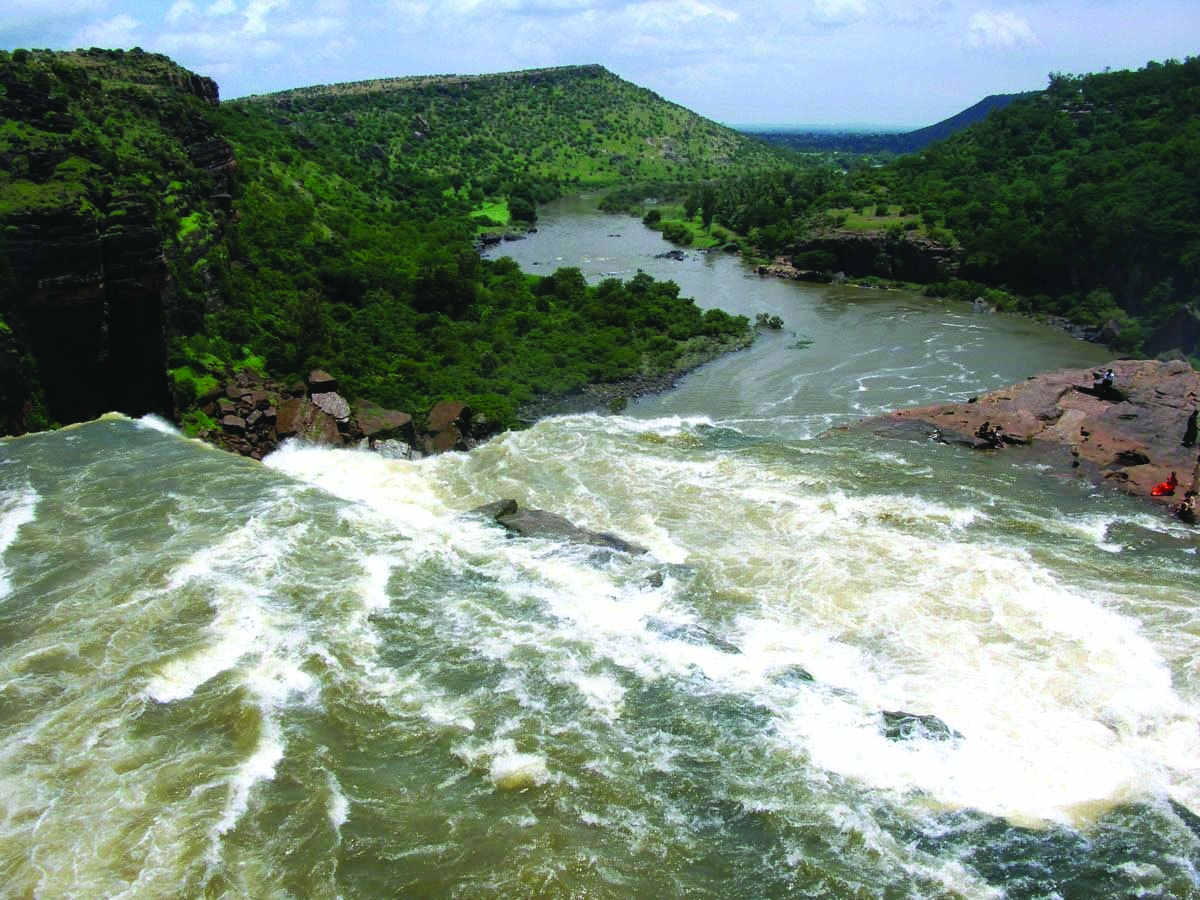In this issue, we feature seven off-the-beaten-track domestic destinations for rest and recreation.

Jabalpur
Sited near the geographic centre of India, Jabalpur (pop. 1.4 million) is one of the major cities of the Hindi heartland state of Madhya Pradesh (pop. 87.4 million). Its defence related industries apart, Madhya Pradesh is famous for its Marble Rocks, a rocky gorge through which the River Narmada flows in profound silence. At Bhedaghat, 27 km from Jabalpur, the rocks rise a hundred feet on either side of the river presenting a fascinating vista during the day, and at nights when expert oarsmen row tourists across the silver nightscape. The sunlight reflects off the marble-white magnesium limestone pinnacles in daytime, prompting them to cast dappled shadows on the pellucid waters, while on moonlit nights the white rocks produce a luminous effect, transforming the waters into a sheet of liquid silver.
The Narmada enters Marble Rocks by dropping several metres, creating the Dhuan Dhar waterfall. To the north and south of the Narmada are the sylvan Vindhyachal and Satpura mountain ranges.
Jabalpur also boasts heritage monuments and sites. Among them: the hilltop Madan Mahal Fort built by Gond ruler, Raja Madan Shah, in 1116; Tilwaraghat, where Mahatma Gandhi’s ashes were immersed in the Narmada, and venue of the open session of the Tripuri Congress in 1939; Rani Durgavati Memorial and Museum with its fine collection of sculptures, inscriptions and prehistoric relics. Also worth a visit is the Chausat Jogini, also known as Ekattarso Mahadeva Temple, a sixty-four goddesses temple atop a hillock accessible via a steep flight of rock cut steps. The temple offers a singularly beautiful view of the Narmada flowing through the jagged Marble Rocks.
Excursions. Ex Jabalpur, an interesting getaway is the Kanha Tiger Reserve (129 km), the largest national park in Central India. Pachmarhi (90 km) is the scenic hill resort of Madhya Pradesh.

Chausath Yogini Temple
Accommodation. A small town, Jabalpur doesn’t offer many options in terms of hotel accommodation. Among the popular ones are Vijan Mahal (Rs.6,956 per night), Hotel B K Castles (Rs.2,820), Hotel Krishna (Rs.2,195), Grand Samdareeya (Rs.1,938).
Belum Caves
Down south in Andhra Pradesh (pop. 55.2 million), the state’s tourism development corporation is aggressively promoting the Belum Caves, an underground 3.25 km long subterranean labyrinth below the limestone plains of Kurnool district. The caves are famous for several natural wonders including 4,000-year-old stalactite and stalagmite formations. Belum is derived from the Sanskrit word bilum which translates into cave.
The main entrance to the caves is via a concrete staircase down a sinkhole, which takes visitors to the main passage 30 ft underground. Walk through the subterranean passages for surreal vistas of stalactites and stalagmites crystallised over numerous millennia. This apart, the caves comprise numerous spacious chambers, freshwater galleries and siphons.

Belum Caves, Karnool District, Andhra Pradesh
Several natural formations have been highlighted with soft illumination by the Andhra Pradesh Tourism Development Corporation. Of special interest are Simhadwaram — an arch with stalactites in the shape of a lion’s head; the Kotilingam Chamber which contains thousands of stalactite formations not unlike shiva lingams; and the Patalaganga, a small perennial stream which disappears into the depths of the earth. The most recently discovered chamber is the Saptasvarala guha or musical chamber, which reproduces musical sounds when stalactites are struck with a wooden stick or knuckles.
Accommodation. The only residential accommodation in the vicinity is APTDC’s Haritha Hotel, which offers AC and non-AC rooms and a multi-cuisine restaurant. For further details and bookings visit www.tourism.ap.gov.in.
Mizoram
Strategically and precariously perched between the somewhat less-than-friendly nations of Myanmar and Bangladesh, the tiny hill state of Mizoram aka Hill People’s Land (pop. 1.27 million) is one of the ‘seven sister’ states of north-east India. Criss-crossed by the Tlawang, Sonai, Tuivawl, Kolodine and Kamaphulr rivers, this land of misty hills is green, mountainous and scenically spectacular with its alpine forests, deep valleys and picturesque lakes interspersed by quaint tribal villages. This lonely north-eastern state boasts rich tribal traditions and folk tales preserved in song and dance culture, pleasant climate and the hospitable culture of its people.
The best time to visit Mizoram is between November and March when skies are clear and the weather is cool. Warm clothing is required for winter and rainwear is mandatory in June-September.

Traditional bamboo dance Mizoram
Aizwal. Sited 3,500 ft above sea level, Aizwal (pop. 370,000), the administrative capital of the state, is the best start-off point to explore Mizoram. Endowed with striking natural beauty, an abundance of flora and fauna, river rapids, Aizwal is an attractive destination for nature, wildlife and environment enthusiasts. The Durtlang hills with their high ridges to the south constitute a natural barrier while in the north, Mizo villages provide a pleasant, rambling countryside. Aizwal’s streets buzz with the sound of guitars, with most street corners featuring local youth strumming and singing tuneful numbers.
Entry formalities for Mizoram. Indian visitors are required to obtain an inner line permit from the Mizoram state government. Liaison officers to assist visitors are posted in Kolkata, New Delhi, Guwahati, Shillong and Silchar. Domestic tourists arriving by air can obtain passes from the Security Officer on arrival at Lengpui Airport, Aizawl. Foreign tourists are required to obtain a Restricted Area Permit from the Union home ministry.
Accommodation. Aizwal offers budget and mid-range accommodation options. Recommended hotels include The Esquire (Rs.4,164 per night), Hotel Regency (Rs.2,948), The Grand Hotel (Rs.2,350), Aziwal Guest House (Rs.1,953).
Chitrakote Falls
Sited in the heart of the newly established state of Chattisgarh (pop. 21 million), Chitrakote Falls are the state’s most famous tourist attraction. Often described as the Niagara of India, Chitrakote marks the spot where the River Indravati plunges 96 ft down a stratified, horseshoe cliff. Sited in the midst of the Kanger Valley National Park (Bastar district), the horseshoe shaped waterfall is the widest in the country, with the water flow aggregating a massive 1,845 cu. metres per second during the monsoon. Illuminated by a perennial rainbow during daytime, and softly aglow with artificial lighting at night, it presents a magnificent sight. The Anthropological Museum, located in Bastar town is also a must-see to learn and understand the region’s tribal culture.
Accommodation. Jagdalpur is the nearest town which offers accommodation options. They include: Naman Bastar Resort (Rs.3,760 per night), Naman Heights (Rs.2,708), Hotel Aaradhya International (Rs.1,410).

Belagavi & Gokak Falls
A scenic rival to Chattisgarh’s Chitrakote Falls is Karnataka’s Gokak Falls, 74 km from Belagavi (pop. 5.1 million). Dropping between tall, rugged sandstone cliffs from a height of 170 ft, the Gokak Falls mark the spot where the River Ghataprabha takes a giant leap over a sandstone cliff, into a picturesque horseshoe gorge to cascade into the Gokak valley with a mighty roar, forming a perpetual cloud-like foam at point of impact. The waterfall spans a breadth of 177 metres as it sweeps over the brink of the cliff. The best time to enjoy the glory of Gokak Falls is July-September when the thundering waters can be heard from miles around.
Another adventure here is a hair-raising walk on a 210-metre hanging bridge which traverses the falls, on which only 30 people are allowed at a time. Also worth visiting are the ancient river-front temples dedicated to Lord Shiva in the form of Takakeshwara, Mahalingeshwara, Mallikarjuna, Kadsiddheshwara and Shanmukha.
While in Belagavi, take in the Kamala Basadi or Lotus Temple, built in the Chalukya style of architecture in 1204 AD. The shrine derives its name from its most striking feature, an imposing 72-petalled lotus carved on the ceiling of the mukhamantapa (outer hall).
Accommodation. Mid-range and budget accommodation options are available in this border town. Fairfield by Marriot (Rs.3,719 per night), Native by Chancery Hotels (Rs.3,290), Hotel Eefa (Rs.2,350), Hotel Samudra (Rs.3,290)
Nubra Valley, Kashmir
Sited within the Ladakh district of the Union territory of Jammu & Kashmir, the Nubra — or green — Valley was formerly an important stop on the trade route connecting Tibet with Turkestan. Also known as the Valley of Flowers, Nubra is well cultivated and fertile and enjoys the best climate in Ladakh. Dominated by a broad, denuded flood plain through which the Nubra and Shyok rivers flow, the valley is carpeted with dense forest, charming villages and a vast area covered by sand dunes.
The proximity of Nubra Valley to the world’s highest battlefield — Siachen Glacier — makes it an inner line area necessitating all visitors, Indian and foreign, to acquire a permit to visit this exotic destination. The permit is issued by the district magistrate’s office in Leh.
Getting there. The only means of access to this remote valley is by road from Leh, headquarters of Ladakh district. Officially this road is open throughout the year, but in winter it is often closed for months.
Diskit. En route to the Nubra Valley take in the 500-year-old Diskit Gompa, showcasing huge statues of the Buddha and Maitreya.
A few miles from Diskit towards Hunder is an area dotted with sand dunes and paradoxically surrounded by snow-capped mountains. Diskit is the natural habitat of the double-humped Bectarian camel. A one-day camel safari from Diskit to Hunder priced at Rs.500 including lunch, is highly recommended.
Accommodation. Diskit has a few hotels which offer comfortable stay and passable local cuisine. Among the best stays within a 10-kilometer radius are Desert Himalaya Resort (Rs.9,588 per night), Stone Edge Hotel (Rs.10,786), Lchang Nang Retreat — The House of Trees (Rs.11,985), Olgok Guest House (Rs.2,444)
A contiguous attraction in the Nubra Valley is the village of Panamil, famous for its hot springs and the last point where tourists are allowed. The healing waters reportedly cure rheumatism and other ailments. The solitary 250-year-old Ensa Gompa is an interesting Buddhist monument in the village.
Kutch
The Rann of Kutch, the state of Gujarat’s western seaboard, is a vast arid plain spanning 27,900 sq. km, separating India from Pakistan. The people of Kutch are essentially nomads and pastoralists. Among the nomads, the Rabaries are the dominant community.
Ahirs, the pastoral tribe of Kutch claim to be the children of Lord Krishna. They are distinguished by their colourful clothing decorated with fine mirror work and embroidery, for which Kutch is nationally famous. In fact, the vibrant, crimson textiles and crafts of this region provide a sharp relief to the monochromatic desert landscape. Bhuj, the capital of Kutch district is the base point for excursions in this unique desert environment. A one-hour drive away is Mandvi, a historic port town located on the shore of the Gulf of Kutch with a beautiful beach and the Vijaya Vilas Palace — a unique amalgam of Dutch, Gothic, Bengali and Rajasthani architecture.
Kateshwar on the Indo-Pak border in northwest Kutch is the best place to view the archaeological treasures, caves and ruins referred to in Huen T’sang’s account of the capital of Kutch in the 7th century. From a hilltop in Kateshwar one can also take in a sweeping vista of the endless Rann, eerie, remote and bereft of human settlement. The Vithone Fossil Park with its large collection of marine and terrestrial animal and plant fossils is also worth visiting.
Accommodation. Among the popular hotels in Bhuj are: The Fern Residency (Rs.6,110 per night), Rann Home Stay Resort (Rs.5,170), Comfort Inn Prince Hotel (Rs.3,478), Hotel Seven sky Clarks Exotica (Rs.2,810).
Also Read: Colours and corals of the Maldives

























